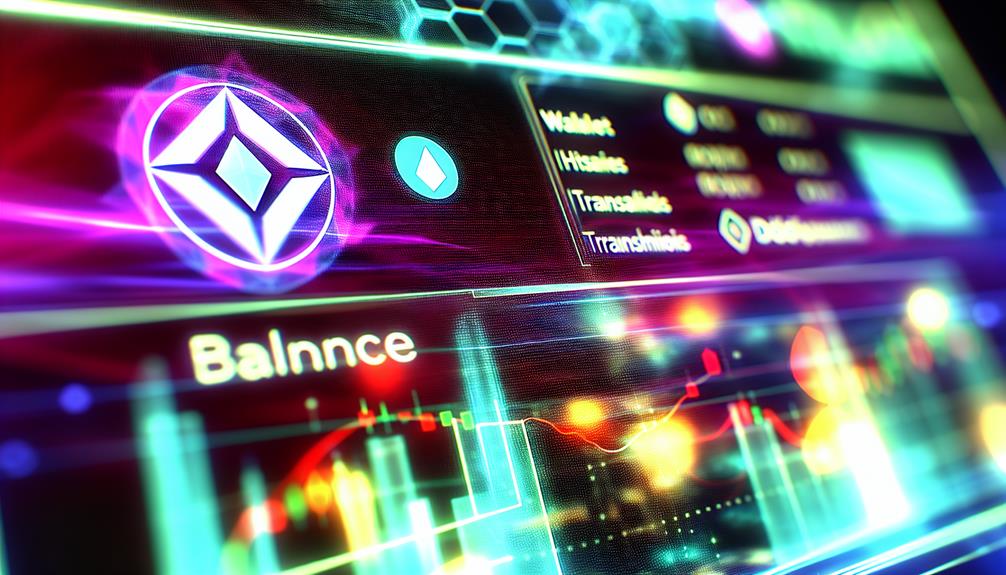If you're looking to track Solana wallets effectively, it's crucial to understand the tools available at your disposal. You'll find that blockchain explorers offer a way to monitor transactions and wallet activity in real-time, providing valuable insights. But it doesn't stop there; leveraging third-party tracking tools can enhance your ability to visualize and manage your assets. However, steering through these options can be a bit intimidating, and you might wonder which methods are the most reliable for your needs. Let's explore the best practices that can streamline your tracking efforts.
Understanding Solana Wallets

A Solana wallet is a digital tool that allows you to store, send, and receive SOL (Solana's native cryptocurrency) as well as other tokens built on the Solana blockchain. Understanding the different wallet types and their features is vital for effective management of your digital assets.
Primarily, there are two main wallet types: custodial and non-custodial wallets. Custodial wallets are managed by third-party services, which means you don't have direct control over your private keys. This can be convenient but poses risks, as the service could be compromised. Non-custodial wallets, on the other hand, give you complete control over your private keys, enhancing security but requiring you to manage your keys diligently.
In terms of wallet features, you should consider aspects like ease of use, security measures, and compatibility with decentralized applications (dApps). Some wallets offer advanced features like multi-signature support or hardware integration, which can greatly enhance security. Additionally, you might look for wallets that provide intuitive user interfaces, making it easier for you to navigate and manage your assets.
When selecting a Solana wallet, it's essential to evaluate which type aligns best with your needs and to assess the features that will support your specific use case. This foundational knowledge will not only help you in securing your assets but will also prepare you for more complex interactions within the Solana ecosystem.
Setting Up Your Wallet
Setting up your Solana wallet is a vital step toward managing your digital assets securely and effectively. You'll first need to decide on the type of wallet that best fits your needs. There are several wallet types available, including mobile wallets, desktop wallets, and hardware wallets. Each has its own advantages and considerations regarding security and ease of use.
When creating wallets, it is important to prioritize securing keys, as these are fundamental for accessing your digital assets. Always generate a strong, unique password and back up your private keys in a secure location. Many wallet interfaces offer features that facilitate wallet integrations with decentralized applications, enhancing your ability to manage tokens efficiently.
If you ever lose access to your wallet, understanding how to restore wallets is vital. Most wallets provide recovery phrases that allow you to regain access, but you must store these securely. This is particularly important for hardware wallets, which are designed for maximum security but still require careful handling of recovery information.
As you set up your wallet, familiarize yourself with the wallet interfaces available. This will help you navigate the process of managing tokens effectively. Whether you're using a mobile wallet for convenience or a desktop wallet for more robust features, knowing how to interact with your wallet's interface will streamline your experience. Ultimately, choosing the right wallet and following best practices will set a strong foundation for your digital asset management.
Using Blockchain Explorers

To effectively track Solana wallets, you need to understand how blockchain explorers function. These tools allow you to monitor transactions in real-time, providing essential insights into wallet activity. By leveraging explorers, you can easily track the flow of tokens and verify transaction details.
Understanding Blockchain Explorers
Using blockchain explorers is essential for anyone looking to track Solana wallets effectively. These tools provide access to blockchain data, enabling you to explore transaction verification and monitor wallet activities in real-time. They offer unparalleled ledger transparency, allowing you to see every transaction associated with a specific wallet address.
When utilizing a blockchain explorer, you can assess network performance by analyzing block confirmation times and identifying any potential bottlenecks in the system. This insight is invaluable for making informed decisions, especially if you're concerned about wallet privacy. By understanding the degree of transparency in your transactions, you can better protect your assets.
Furthermore, blockchain explorers facilitate decentralized tracking, ensuring that you can monitor transactions without relying on a centralized authority. They also enhance wallet interoperability, allowing you to interact with various wallets seamlessly. Additionally, you can use these explorers for fee estimation, which can help you select the best time to execute transactions based on network congestion.
Lastly, data visualization features often included in explorers let you interpret complex data quickly, giving you a thorough overview of wallet activities and trends. This knowledge empowers you to manage your Solana assets more effectively.
Tracking Transactions Easily
Blockchain explorers not only provide a way to access wallet data but also simplify the process of tracking transactions across the Solana network. By utilizing these tools, you can monitor your wallet's activity and receive transaction alerts that keep you informed in real-time.
When you check a transaction's status, you'll often find critical information such as confirmations and timestamps. Here's a quick overview of what you can expect while tracking:
| Feature | Description |
|---|---|
| Transaction Alerts | Immediate notifications for every transaction. |
| Wallet Notifications | Updates on wallet activity and balance changes. |
Using blockchain explorers allows you to set up wallet notifications, ensuring you're always in the loop. Whether you're sending or receiving funds, knowing the status of your transactions can give you peace of mind. The analytical nature of these platforms means you can dissect transaction histories and analyze patterns over time.
Tracking Transactions and Balances
To effectively track transactions and balances in your Solana wallet, you'll need to monitor the wallet's balance regularly and analyze its transaction history. This process involves utilizing blockchain explorers to extract real-time data, allowing for a clear understanding of your wallet's activity. By systematically reviewing this information, you can make informed decisions regarding your assets.
Monitoring Wallet Balances
Monitoring wallet balances involves closely tracking both transactions and the overall balance of your Solana wallet, which can greatly enhance your understanding of your holdings. To effectively monitor your wallet, consider implementing wallet balance alerts. These alerts notify you of any significant changes in your balance, ensuring you're always informed of fluctuations that could impact your investment strategy.
You should also regularly perform transaction history comparisons. By analyzing your transaction history, you can identify patterns in your spending and receiving habits. This comparison helps you discern whether your wallet balance aligns with your expectations based on your activity.
Utilizing tools like Solana Explorer can provide real-time insights into your wallet balance and transaction history. By inputting your wallet address, you can access detailed data, including transaction amounts, timestamps, and sender/receiver addresses. This level of detail enables you to maintain an accurate picture of your financial landscape.
Analyzing Transaction History
Analyzing your transaction history is essential for understanding the dynamics of your Solana wallet. By closely examining your transactions, you can uncover valuable insights into your wallet behaviors and identify transaction patterns that may indicate trends or potential issues.
Here are three key areas to focus on:
- Frequency of Transactions: Track how often you send or receive funds. A consistent pattern might suggest regular trading activity, while sporadic transactions could indicate infrequent use or specific investment strategies.
- Transaction Amounts: Pay attention to the amounts involved in your transactions. Large transfers may signify significant investments or withdrawals, while smaller, frequent transactions may reveal a more cautious trading approach.
- Transaction Types: Analyze whether you're primarily engaging in swaps, transfers, or staking. Each type of transaction can reflect different wallet behaviors—some might focus on trading, while others may prioritize earning rewards through staking.
Third-Party Tracking Tools

Many users find that third-party tracking tools provide an efficient way to monitor Solana wallets. These tools often specialize in wallet analytics, allowing you to gain insights into transaction patterns and wallet activities. By utilizing APIs and blockchain data, these platforms aggregate information from various sources, making it easier for you to track multiple wallets in one place.
One key feature of these tracking tools is transaction visualization. This function enables you to see the flow of assets, highlighting incoming and outgoing transactions in a clear, graphical format. This visual representation can help you quickly identify significant changes in wallet activity or detect unusual transactions that may warrant further investigation.
Moreover, many third-party tools offer customizable dashboards, allowing you to tailor the data display according to your specific needs. This flexibility can enhance your monitoring capabilities, providing you with deeper insight into market trends and wallet performance. Some tools even support alerts for specific transactions or wallet activities, helping you stay informed without the need for constant manual checks.
It's essential to choose a tracking tool that aligns with your goals. Evaluate features like user interface, supported wallets, and integration capabilities with other services. By leveraging these third-party tools, you can enhance your understanding of Solana wallets, making informed decisions based on detailed wallet analytics and thorough transaction visualizations.
Security Best Practices
When it comes to securing your Solana wallet, implementing best practices is crucial to protect your assets from potential threats. By adopting a systematic approach to security, you can markedly reduce the risk of unauthorized access and theft.
Here are three key strategies to enhance your wallet security:
- Secure Backups: Regularly back up your wallet data and store these backups in multiple secure locations. This guarantees that you'll have access to your wallet even if your device is compromised. Consider using cold storage solutions for additional protection.
- Two-Factor Authentication: Always enable two-factor authentication (2FA) when available. This adds an extra layer of security, making it harder for attackers to gain access to your wallet. Even if someone obtains your login credentials, they won't be able to access your wallet without the second factor.
- Phishing Awareness: Stay vigilant against phishing attacks. Always verify the authenticity of links and emails before entering sensitive information. Familiarize yourself with common phishing techniques to better identify potential threats.
In addition to these strategies, consider using multi-signature wallets for enhanced security, which require multiple approvals for transactions. Implement strong wallet encryption and practice proper private key management. Conduct regular security audits to identify vulnerabilities and guarantee your defenses remain robust. By following these best practices, you'll create a formidable barrier against potential threats, guaranteeing the safety of your Solana assets.
Frequently Asked Questions
Can I Track Multiple Solana Wallets Simultaneously?
Yes, you can track multiple Solana wallets simultaneously. Utilizing wallet tracking tools designed for simultaneous monitoring allows you to efficiently manage and analyze transactions across various wallets, ensuring thorough oversight of your crypto activities.
Are There Fees Associated With Tracking Solana Wallet Transactions?
Yes, there're transaction costs and gas fees associated with tracking Solana wallet transactions. While monitoring activities, you may incur these fees depending on the platform or service you use, so be mindful of potential expenses.
How Often Is Solana Wallet Data Updated in Explorers?
On average, Solana blockchain data updates occur every 400 milliseconds. You'll find this impressive frequency allows for near real-time tracking, ensuring you're always informed about wallet transactions and activities with minimal delay.
Can I Track Wallets Anonymously Without Creating an Account?
Yes, you can track wallets anonymously without creating an account. Utilizing public blockchain explorers and various tracking methods, you can monitor transactions while maintaining wallet privacy, ensuring your identity remains unlinked to the tracking activity.
What Happens if a Wallet Is Compromised?
If your wallet's compromised, you might lose assets. Wallet security's essential; consider recovery options like seed phrases or backup keys. Act quickly to mitigate damage, ensuring you understand your wallet's vulnerabilities and protective measures.
Conclusion
In summary, while tracking Solana wallets might seem like a complex endeavor, it's ironically simple when you embrace the right tools. You've got blockchain explorers at your fingertips, ready to reveal every transaction detail. Yet, remember, the more you monitor your assets, the more you realize how much they can fluctuate. So, while you think you're in control, the market might just have other plans. After all, in the world of crypto, unpredictability is the only certainty.
